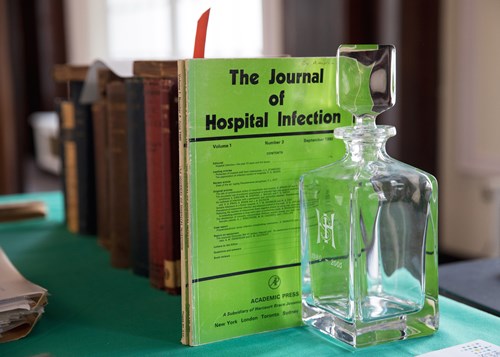

 Could you tell us a bit more about your professional background?
Could you tell us a bit more about your professional background?I did general medical training and then, after passing my Membership of the Royal Colleges of Physicians exams, I entered microbiology registrar training.
During that training, I developed an interest in infection prevention and control (IPC) by working on outbreak management and publishing and presenting research in this area. I led work on perineal shedding of group A streptococcus, which was published as an outbreak report, and then I worked on another group A strep outbreak which was published in the Journal of Hospital Infection (JHI) as a short report which showed how curtains became contaminated.
Those are the two projects which stimulated my interest in IPC, and led me to do a project looking at socks – basically, when you come into hospital without shoes they give you ‘gripper socks’ to walk in so you don't fall over. They’re supposed to be single use, but what does single use mean in this context? One walk, and then you come back and you change them? Or do you wear them for a week or a month or a day? So we did a little project which we published in the JHI which showed contamination of those – we found VRE, MRSA, all sorts of things on those socks.
I loved the more scientific approach. IPC is challenging, and it involves a lot of different aspects, from building development, to managing the environment – water, ventilation – to thinking about individual patient care, and then thinking about big surveillance monitoring projects. But doing and sharing research ties it all together.
IPC as a field makes you think quite widely across the patient journey, from the moment when they step into the hospital. Because it could be the ventilator, the floor – you know, something in the environment itself – which could lead them to pick up infections. I liked the thought of the scope of the overall care – treating the patient is about thinking how you can look after them in the whole environment. I have a strong interest in environment, basically!
I first published in the JHI in 2013 – colleagues and I were the first to trial one of the first ultraviolet-C devices that arrived in the UK for terminal room disinfection. We published a short report about this.
I then received a Small Research Grant from HIS for a short research project during my MSc in Clinical Microbiology. The project looked at whether IV lines and syringes can become contaminated during routine anaesthetic practice, and was published in JHI. The grant covered all the equipment and consumables I needed to do the project. Since then I have published a number of small research projects and outbreak reports in the JHI.
I got more involved with HIS as a trainee representative in 2015-2016, which was followed by the HIS Graham Ayliffe Fellowship.
I was at the end of my training when I applied, so I could have gone on to become a consultant. But, because I'd already decided I wanted to do IPC, I wanted to make sure that I had experienced what it was like and I wanted to have the full skillset to be the infection control doctor for an organization. So it was really an opportunity to take on that role, but while having colleagues around to supervise me and help me build confidence.
At the same time, there was this opportunity to train to be an editor as part of the fellowship. So the stars kind of lined up there! But for me the main thrust was to be able to say: this is my interest, I really want to become good at this. I want to spend more time doing it and develop my skillset in it.
The Graham Ayliffe Fellowship is unique. There really aren’t many fellowships in microbiology that allow you to develop an in-depth subspecialist interest like IPC. I think doing the Fellowship definitely strengthened my CV and made me more employable because of this.
 Was becoming more involved with research journals something you had planned before embarking on the Fellowship?
Was becoming more involved with research journals something you had planned before embarking on the Fellowship?The Fellowship was not proscribed – I had to shape it to suit what I wanted to achieve. I didn’t really know what was involved in editorial work in any detail, but it seemed like an opportunity you don't get very often.
By that point, I had published quite a few papers, and I was interested in publishing, editing and how it all worked. Jim [Gray, outgoing Editor in Chief of the JHI) had just become the Editor in Chief. I remember meeting him at a Costa outside a train station near where he lived. We had a chat about what I wanted to learn and how it might work, and agreed that to begin with he would screen manuscripts to send to me, and I would peer review them.
Eventually, I was handling manuscripts as the sole editor, writing editorials, commissioning work, planning special sections… And during that period I spent a day with Elsevier, at their HQ, and I shadowed the Lancet Infectious Diseases Editor in Chief. It was interesting to see how full-time editors worked. Their life revolves around the papers – even in their lunch break they would be looking at other Lancet papers.
It's a unique opportunity. It's a real chance to understand the peer review process and develop your own knowledge and skills: to be able to read journal papers and develop an understanding of the pitfalls of research, the things that could have been done better and the aspects that have been done really, really well.
It brings you really quickly up to date with what's going on in the world of IPC globally, and you maintain that understanding because you're constantly reading manuscripts that are coming through on the cutting edge, and watching areas of interest evolve. It also gives you insight into your own research – it helps you formulate how you would approach a research project and write it up, having seen other people do it.
IPC is a very niche area. It's not for everyone necessarily, but it's recognized as being of high importance – especially now with a pandemic. Having good infection control doctors across the country actually makes a difference, not only at local level, but also at a national level. As a journal editor, you can really help drive national agendas around IPC and improving care of patients – whether that's publishing large surveillance point prevalence studies, or novel aspects around decontamination, or ensuring that there are good guidelines and resources for when you're building new hospitals, refurbishing or redoing wards.
The JHI achieved its highest ever impact factor this year – 8.944. My vision for the JHI is to build on this achievement, ensuring the JHI remains the leading international journal for publishing infection prevention and control (IPC) studies.
The COVID-19 pandemic has placed a renewed focus on the importance of infection prevention and control. One important strategy for the JHI will be to keep abreast of emerging and developing areas within IPC and make sure we are commissioning the best papers in these areas – COVID-19 is not going anywhere of course, but also Mycobacterium chimera outbreaks and heater-coolers, the emergence of Candida auris and new outbreaks of existing pathogens – like MonkeyPox and Ebola – are key issues.
The outbreaks I mentioned demonstrate that IPC is a worldwide challenge and there continue to be global aspects affecting IPC such as the spread of multi-resistant Gram-negative bacteria. In addition, there is increasing globalisation of research, with international collaboration and more resources for research emerging in Asia, particularly China and India. Currently the JHI receives a significant number of articles from Asia and we should increase representation on our international editorial board (IEB) of colleagues from these countries, and utilise their local knowledge to receive higher-quality submissions.
Finally, the JHI has developed a close and good working relationship with our open access sister journal, Infection Prevention in Practice (IPIP), and its editorial team over the last few years. I want to maintain and build on this to the mutual benefit of both journals.
One the greatest changes occurring in journal publication is the digitisation of content. If the JHI team embrace this digital revolution – the use of social media and other digital forms of communication – we can better engage with the IPC community that exists around the world.
The COVID-19 pandemic has further accelerated this process of digitisation and a move from reading printed material to online access, due to the need for rapid delivery of information. In addition, readers have less time to dedicate to reading, but there is increasing content to be read. Hence it will be important that we are able to deliver JHI content in multiple online formats and in an easily digestible format, with further access to the fuller content if required by the reader – or listener.
However, in the absence of a significant print production it will also be important that the JHI continues to maintain its unique identity, including online, for example through the JHI and HIS websites.
In addition to the strategies above, there will be a need to maintain and improve editorial aspects which appeal to authors such as:
 Any other reasons why HIS members should consider publishing in the JHI over other journals in the field?
Any other reasons why HIS members should consider publishing in the JHI over other journals in the field?As mentioned, our impact factor of 8.944 makes us one of the leading IPC-focused journals there is. Since the COVID-19 pandemic began, papers published in the journal received over 5 million downloads, and our authors and readers come from across the globe.
We work hard to maintain an independent and transparent editorial process, as well as being quick – with a time from initial submission to acceptance of 9-10 weeks.
Finally, for both HIS journals HIS authors get a 20% discount on open access fees if they choose the open access publication route! HIS members can also access the paywalled element of the JHI via the membership page.
Tell us a bit more about the subject areas the journal specialises in. Which topics do you think are currently of interest to the IPC community?
The JHI publishes in a wide range of areas of interest to the IPC community – including antimicrobial stewardship and surgical site infections, and work which increases recognition of the built environment in controlling the spread of respiratory infections including aspects of air quality, ventilation, single-rooms versus multi-occupancy rooms, water quality and control of new emerging pathogens, and the role of sinks and drains designs in reducing cross-contamination
During the height of the COVID-19 pandemic, the JHI published work on transmission of COVID – Tang et al.’s dismantling myths on the airborne transmission of SARS-CoV-2 was published in January 2021, and the joint British Infection Association (BIA), HIS, Infection Prevention Society (IPS) and Royal College of Pathologists (RCPath) guidance on two routes of transmission and recommendations for preventing acquisition was published in April 2021.
Emerging issues included the impact of healthcare on the environment – both in terms of sustainability of single use and reusability, and the carbon footprint of the health sector.
Interviewed by Christine Fears.
To find out more about the JHI click here.
To submit click here.
Bak A, Mugglestone MA, Ratnaraja NV, Wilson JA, Rivett L, Stoneham SM, et al. SARS-CoV-2 routes of transmission and recommendations for preventing acquisition: joint British Infection Association (BIA), Healthcare Infection Society (HIS), Infection Prevention Society (IPS) and Royal College of Pathologists (RCPath) guidance. Journal of Hospital Infection. 2021; 114:79-103 https://doi.org/10.1016/j.jhin.2021.04.027
Bolten A, Kringos DS, Spijkerman IJB, Sperna Weiland NH. The carbon footprint of the operating room related to infection prevention measures: a scoping review. Journal of Hospital Infection. 15 July 2022; In press https://doi.org/10.1016/j.jhin.2022.07.011
Inkster T, Weinbren M. Water springing to life the fungal desert. Journal of Hospital Infection. 2021; 111:65-68. https://doi.org/10.1016/j.jhin.2021.02.015
Jamal H, Lyne A, Ashley P, Duane B. Non-sterile examination gloves and sterile surgical gloves: which are more sustainable? Journal of Hospital Infection. 2021; 118:87-95. https://doi.org/10.1016/j.jhin.2021.10.001
Lee Y-L, Liu K-M, Chang H-L, Lin J-S, Kung F-Y, Ho C-M et al. A dominant strain of Elizabethkingia anophelis emerged from a hospital water system to cause a three-year outbreak in a respiratory care center. Journal of Hospital Infection. 2021; 108:43-51. https://doi.org/10.1016/j.jhin.2020.10.025
Mahida N, Beal A, Trigg D, Vaughan N, Boswell T. Outbreak of invasive group A streptococcus infection: contaminated patient curtains and cross-infection on an ear, nose and throat ward. Journal of Hospital Infection. 2014; 87:141-144. https://doi.org/10.1016/j.jhin.2014.04.007
Mahida N, Boswell T. Improving the detection rate of vancomycin-resistant enterococci colonisation using groin swabs. Journal of Clinical Pathology. 2014; 67:544-545. http://dx.doi.org/10.1136/jclinpath-2013-202109
Mahida N, Boswell T. Non-slip socks: a potential reservoir for transmitting multidrug-resistant organisms in hospitals? Journal of Hospital Infection. 2016; 94:273-275. https://doi.org/10.1016/j.jhin.2016.06.018
Mahida N, Levi K, Kearns A, Snape S, Moppett I. Investigating the impact of clinical anaesthetic practice on bacterial contamination of intravenous fluids and drugs. Journal of Hospital Infection. 2015; 90:70-74. https://doi.org/10.1016/j.jhin.2014.11.024
Mahida N, Vaughan N, Boswell T. First UK evaluation of an automated ultraviolet-C room decontamination device (Tru-D™). Journal of Hospital Infection. 2013; 84;332-335. https://doi.org/10.1016/j.jhin.2013.05.005
Tsantes AG, Papadopoulos DV, Lytras T, Tsantes AE, Mavrogenis AF, Koulouvaris P et al. Association of malnutrition with surgical site infection following spinal surgery: systematic review and meta-analysis. Journal of Hospital Infection. 2019; 104:111-119. https://doi.org/10.1016/j.jhin.2019.09.015